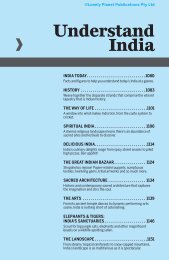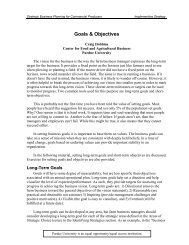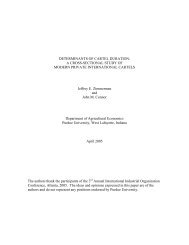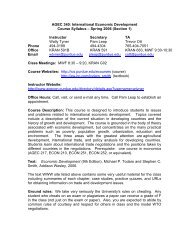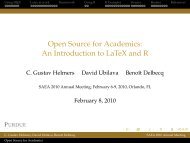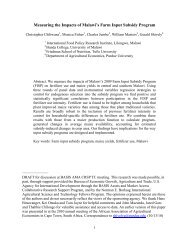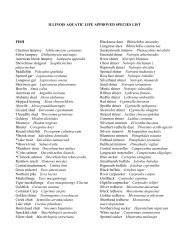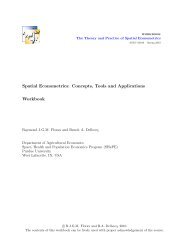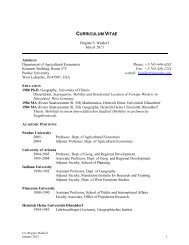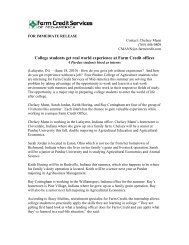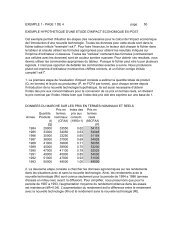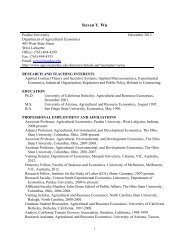AGEC 352 Fall 2007 Course Syllabus Course Name - Department of ...
AGEC 352 Fall 2007 Course Syllabus Course Name - Department of ...
AGEC 352 Fall 2007 Course Syllabus Course Name - Department of ...
Create successful ePaper yourself
Turn your PDF publications into a flip-book with our unique Google optimized e-Paper software.
<strong>AGEC</strong> <strong>352</strong> <strong>Fall</strong> <strong>2007</strong><br />
<strong>Course</strong> <strong>Syllabus</strong><br />
<strong>Course</strong> <strong>Name</strong>:<br />
Agricultural Economics <strong>352</strong>, Quantitative Techniques for Firm Decision Making<br />
<strong>Course</strong> Website:<br />
The course website below will be maintained until further notice. It is hoped that a WebCT<br />
version <strong>of</strong> the course webpage will be up and running by the second week <strong>of</strong> the semester.<br />
http://www.agecon.purdue.edu/academic/agec<strong>352</strong><br />
Instructor: Roman Keeney<br />
Secretary: Sandy Dottle<br />
Office: Krannert 692 Office: Krannert 688<br />
Teaching Assistant: Joe Suttles (more info to be announced)<br />
Office Hours: MW 10:30-11:30 (or by appointment)<br />
Meeting Times:<br />
Lecture: MW 9:30-10:20 Krannert Bldg., Room G-16<br />
Laboratory: Tuesday 10:30- 11:45 Krannert 756 Lab, (Lab 1)<br />
Tuesday 12:00- 1:15 Krannert 756 Lab, (Lab 2)<br />
<strong>Course</strong> Objectives<br />
<strong>AGEC</strong> <strong>352</strong> is a course dealing with the application <strong>of</strong> quantitative tools to support<br />
management problem solving. This course involves studying management problems,<br />
identifying important decision variables, developing alternatives, evaluating alternatives, and<br />
selecting the most promising alternative. To support the evaluation <strong>of</strong> alternatives, the<br />
course will emphasize the construction, solution, and interpretation <strong>of</strong> mathematical models<br />
with particular emphasis on linear programming and simulation models. As such, it requires<br />
some knowledge and use <strong>of</strong> mathematics, statistics, management principles, and computer<br />
spreadsheet s<strong>of</strong>tware. There are no instructor prescribed prerequisites for taking this class,<br />
but an introductory level course in applied computing (e.g. <strong>AGEC</strong> 202) and statistics (e.g.<br />
STAT 305) should provide the proper background. As with almost any upper division<br />
<strong>AGEC</strong> course a working knowledge <strong>of</strong> microeconomic principles is fundamental.<br />
By the end <strong>of</strong> the course, the student should have acquired the following skills:<br />
1. Manipulate and use spreadsheets.<br />
2. Formulate linear programming problems.<br />
3. Solve linear programming problems in Excel.
4. Interpret results obtained from linear programming models.<br />
5. Present and explain linear programming results.<br />
6. Understand graphically the concept <strong>of</strong> optimality in a linear program.<br />
7. Understand the properties <strong>of</strong> optimal linear programming solutions.<br />
8. Recognize and demonstrate instances where linear programming and simulation modeling<br />
might be valuable.<br />
These objectives will be achieved primarily by close examination <strong>of</strong> example problems.<br />
Example problems will be either classic problems in linear programming or practical<br />
examples from farm management or agri-business.<br />
<strong>Course</strong> Grading<br />
The course grade will be determined from performance on three exams (50%) and<br />
homework and quizzes (combined 50%). Each exam will be progressively weighted and will<br />
be comprehensive to that point <strong>of</strong> the class. Homework will be periodically assigned and will<br />
be equally weighted. Extra credit projects or assignments will not be <strong>of</strong>fered. Makeup<br />
assignments, quizzes, and exams are allowed for University excused absences, please contact<br />
the instructor.<br />
The standard grading scale will be applied as follows subject to downward revision <strong>of</strong> the<br />
grade thresholds:<br />
Homework Assignments<br />
Grade Greater than But less than<br />
A 90% --<br />
B 80% 90%<br />
C 70% 80%<br />
D 60% 70%<br />
F -- 60%<br />
Homework assignments will require the application <strong>of</strong> the tools discussed in class. When<br />
working on an exercise and/or case problem, you are encouraged to discuss your ideas or<br />
proposed solutions with others. Working together, it is <strong>of</strong>ten possible to make discoveries<br />
that we would not have made on our own and to learn more quickly. A single consensus<br />
homework paper should be turned in for everyone that contributes to the development <strong>of</strong><br />
answers. No more than three persons should work together on a given assignment.<br />
Homework assignments are to be completed by the beginning <strong>of</strong> class on the date due. Late<br />
homework will be assessed a 10% penalty for each day overdue.<br />
Quizzes
Quizzes will be held periodically through the semester and will include questions that are<br />
reflective <strong>of</strong> recently covered material and indicative <strong>of</strong> exam questions. They will cover<br />
material presented in class, in assigned readings, and in homework assignments. Some quiz<br />
topics and dates will be announced in class, but I reserve the right to give an unannounced<br />
quiz.<br />
In addition to occasional in-class quizzes, WebCT assessments will be assigned as well and<br />
will count as quizzes.<br />
Exams<br />
Three exams will be given, two during the semester and a third during finals week. Each<br />
exam will be progressively weighted as indicated below. All exams are comprehensive with<br />
respect to material covered prior to that point in the class.<br />
Computer Use<br />
Exam<br />
Percent <strong>of</strong><br />
Final Grade<br />
Exam I 10%<br />
Exam II 15%<br />
Exam III 25%<br />
Students are expected to know how to use a microcomputer and the basics <strong>of</strong> spreadsheet<br />
s<strong>of</strong>tware such as Excel. Excel will be the primary s<strong>of</strong>tware tool used in class.<br />
<strong>Course</strong> Schedule<br />
A course schedule will be given out during the first week. This document indicates the<br />
planned lecture topic and accompanying text material for a particular day. It will also<br />
tentatively outline other predetermined events such as exam dates and homework<br />
assignment due dates. This plan is flexible in most respects and student input will be<br />
important in its revision. If the class is progressing too slowly or too rapidly, please let me<br />
know so that we can reach agreement as a class on how to make adjustments. If there are<br />
other topics that you would like to have covered, please suggest these so that they can be<br />
considered.<br />
Assistance Outside Class<br />
Class time is limited, so it may not be possible to answer all <strong>of</strong> your questions during class. If<br />
you have questions that you would like to discuss outside class time and the reserved <strong>of</strong>fice<br />
hours, you are encouraged to contact my secretary Sandy (dottle@ purdue.edu) or me<br />
(rkeeney@ purdue.edu) for an appointment. In discussing your questions, please come<br />
prepared. Our discussion will be more productive if you have thought about your question(s)<br />
and written them out. If your question deals with a computer problem, you will need to<br />
bring a copy <strong>of</strong> the current file you are using. Without this file or a copy <strong>of</strong> the input and<br />
output, it is impossible to locate the problem.
It is especially important to hear from you when you are frustrated with this class. If you are<br />
frustrated or unhappy with the course for any reason, contacting me will indicate concern<br />
and hopefully will result in some relief.<br />
Academic Integrity<br />
Each student enrolled in <strong>AGEC</strong> <strong>352</strong> is encouraged to study and work exercises with others.<br />
That said, this class abides by the University policy on academic integrity as embodied in the<br />
following statement:<br />
University policy on academic misconduct is clear - academic dishonesty in any form is<br />
strictly prohibited. Instances <strong>of</strong> academic dishonesty will be referred to the Dean <strong>of</strong> Students<br />
for disciplinary action. Penalties are severe and may include failure on the exam, quiz, paper,<br />
or project, failure in the course, and/or expulsion from the University. The risks associated<br />
with academic dishonesty far outweigh the perceived benefits. Academic dishonesty includes<br />
citing someone else's work as your own, using unauthorized "crib sheets" during exams, or<br />
sharing your answers with someone else. If you are unsure whether an action you are<br />
considering constitutes academic dishonesty, seek clarification from your instructor.<br />
Score Revisions<br />
The instructor or teaching assistant grades all <strong>of</strong> your work and sometimes makes errors. If<br />
the error lowers your grade it is your responsibility to inform the instructor <strong>of</strong> his mistake.<br />
This can be done by checking your work against that <strong>of</strong> classmates, posted answer keys, or<br />
discussion with the instructor.<br />
Reading Materials/ Required Text<br />
There is no required text for this course. A copy <strong>of</strong> Decision Modeling with Micros<strong>of</strong>t Excel, 6th<br />
edition, by Moore, Weatherford, Eppen, Gould, and Schmidt, Prentice Hall, 2001 will be<br />
placed on reserve and is a useful reference for the course. Previous students have had good<br />
success finding cheap used versions <strong>of</strong> this book on the internet (without the CD is fine).<br />
Assigned reading will be provided to you in the form <strong>of</strong> handouts posted to the course<br />
website.



